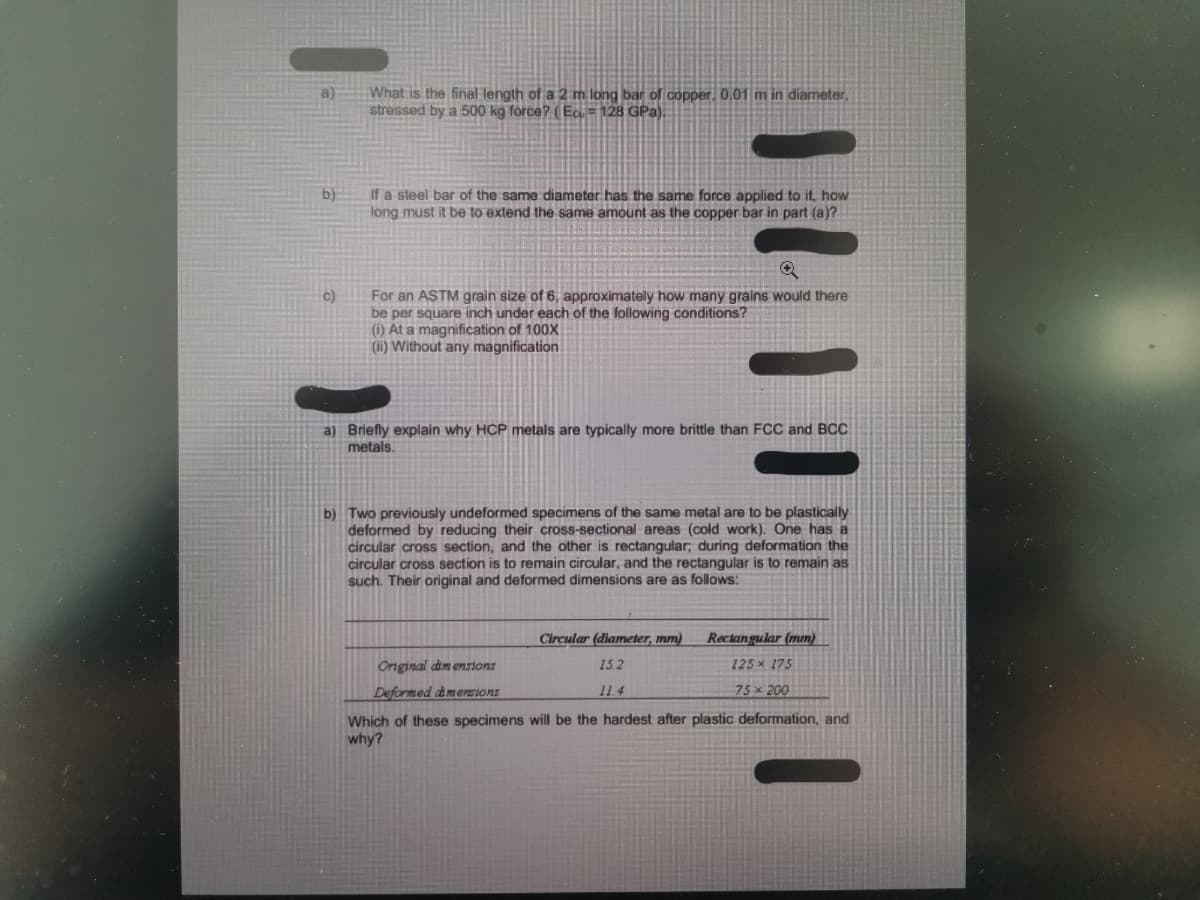b) What is the final length of a 2 m long bar of copper, 0.01 m in diameter, stressed by a 500 kg force? (Ec=128 GPa). If a steel bar of the same diameter has the same force applied to it, how long must it be to extend the same amount as the copper bar in part (a)?
b) What is the final length of a 2 m long bar of copper, 0.01 m in diameter, stressed by a 500 kg force? (Ec=128 GPa). If a steel bar of the same diameter has the same force applied to it, how long must it be to extend the same amount as the copper bar in part (a)?
Elements Of Electromagnetics
7th Edition
ISBN:9780190698614
Author:Sadiku, Matthew N. O.
Publisher:Sadiku, Matthew N. O.
ChapterMA: Math Assessment
Section: Chapter Questions
Problem 1.1MA
Related questions
Question

Transcribed Image Text:What is the final length of a 2 m long bar of copper, 0.01 m in diameter,
stressed by a 500 kg force? (Ecu=128 GPa).
b)
If a steel bar of the same diameter has the same force applied to it, how
long must it be to extend the same amount as the copper bar in part (a)?
Q
For an ASTM grain size of 6, approximately how many grains would there
be per square inch under each of the following conditions?
(i) At a magnification of 100X
(ii) Without any magnification
a) Briefly explain why HCP metals are typically more brittle than FCC and BCC
metals.
b) Two previously undeformed specimens of the same metal are to be plastically
deformed by reducing their cross-sectional areas (cold work). One has a
circular cross section, and the other is rectangular; during deformation the
circular cross section is to remain circular, and the rectangular is to remain as
such. Their original and deformed dimensions are as follows:
Circular (diameter, mm)
Rectangular (mm)
125* 175
Original dimensions
15.2
Deformed dimensions
11.4
75 x 200
Which of these specimens will be the hardest after plastic deformation, and
why?
Expert Solution
This question has been solved!
Explore an expertly crafted, step-by-step solution for a thorough understanding of key concepts.
Step by step
Solved in 2 steps with 2 images

Knowledge Booster
Learn more about
Need a deep-dive on the concept behind this application? Look no further. Learn more about this topic, mechanical-engineering and related others by exploring similar questions and additional content below.Recommended textbooks for you

Elements Of Electromagnetics
Mechanical Engineering
ISBN:
9780190698614
Author:
Sadiku, Matthew N. O.
Publisher:
Oxford University Press

Mechanics of Materials (10th Edition)
Mechanical Engineering
ISBN:
9780134319650
Author:
Russell C. Hibbeler
Publisher:
PEARSON

Thermodynamics: An Engineering Approach
Mechanical Engineering
ISBN:
9781259822674
Author:
Yunus A. Cengel Dr., Michael A. Boles
Publisher:
McGraw-Hill Education

Elements Of Electromagnetics
Mechanical Engineering
ISBN:
9780190698614
Author:
Sadiku, Matthew N. O.
Publisher:
Oxford University Press

Mechanics of Materials (10th Edition)
Mechanical Engineering
ISBN:
9780134319650
Author:
Russell C. Hibbeler
Publisher:
PEARSON

Thermodynamics: An Engineering Approach
Mechanical Engineering
ISBN:
9781259822674
Author:
Yunus A. Cengel Dr., Michael A. Boles
Publisher:
McGraw-Hill Education

Control Systems Engineering
Mechanical Engineering
ISBN:
9781118170519
Author:
Norman S. Nise
Publisher:
WILEY

Mechanics of Materials (MindTap Course List)
Mechanical Engineering
ISBN:
9781337093347
Author:
Barry J. Goodno, James M. Gere
Publisher:
Cengage Learning

Engineering Mechanics: Statics
Mechanical Engineering
ISBN:
9781118807330
Author:
James L. Meriam, L. G. Kraige, J. N. Bolton
Publisher:
WILEY